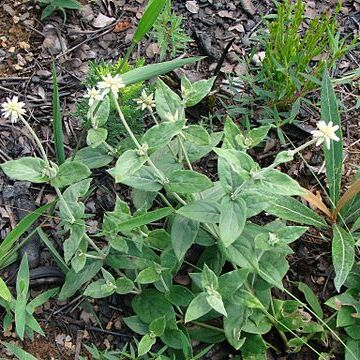Perennial herbs, clambering vines or erect subshrubs, often with thick rootstock, usually pubescent; stem branched, often with interpetiolar ridges and a tuft of hairs in leaf-axils. Leaves opposite, simple, entire, pinnately veined, subsessile to petiolate, exstipulate. Inflorescence of dense terminal heads, or flowers distant and borne singly in short spikes arranged in diffuse, axillary or terminal, long-pedunculate cymes or panicles. Flowers bisexual, sessile, subtended by 1 ventral bract and 2 lateral bracteoles. Tepals 5, free, scarious, concave, subequal, outer 3 somewhat larger and distinctly longitudinally 3-ribbed (-veined), greenish-white, sometimes inside with a tuft of straight white hairs, exceeding perianth; stamens 5, filaments expanded and connate below in a cup, cup and filaments with or without apical appendages, anthers 2-locular, becoming 1-locular at anthesis, introrse, medifixed, pseudostaminodia absent; ovary ovoid or obovoid, ovule 1, campylotropous, placentation basal, with flattened, elongated funicle, stigma sessile, capitate or 2-lobed. Fruit a membranous, indehiscent capsule (sometimes designated a utricle) included in tepals; seed 1, lenticular, cochleate-orbicular, smooth.
More
Flowers normally perfect, bracteate and bibracteolate, sessile, often with an unpleasant odor. Sepals 5, discrete, hypogynous, concave, subequal, the outer 3 slightly larger, often 3-ribbed, greenish white, becoming scariose, with a con-spicuous tuft of intertwined whitish hairs arising mostly within and longer than the outer sepals. Stamens 5, the filaments flattened and united below forming an entire or appendiculate tube; anthers 2--locellate, introrse, medially attached. Ovary ovoid to obovoid, I-locular, 1-ovulate; ovules campylotropous on elongate flattened funicles; style 1, very short; stigma 1, bilabiate, exceeding the style. Fruit an indehiscent utricle; seeds cochleate-orbiculate, reddish brown. Subglabrous or copiously pubescent clambering vines or erlect shrubs. Leaves opposite, entire to undulate, subsessile to short petiolate, glabrate to densely pubescent. Inflorescences paniculate with opposite branches or verticillate branches ultimately bearing spikes.

